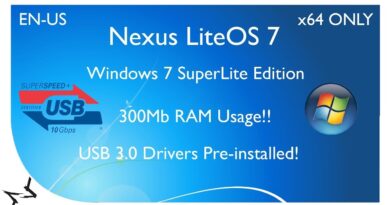Why Windows Vista Failed (From Windows Longhorn to Windows 7)
This video explains a detailed timeline of the events for why Windows Vista failed in becoming not only one of the most ambitious and innovative operating systems Microsoft had ever released.
In 2007, Microsoft officially released its latest version of the Windows operating system: Vista. It included many overhauls to the Windows experience, and its entire structuring surrounded a concept that would also become a part of Microsoft’s marketing slogan: “bringing clarity to your world.” But for many people, Vista brought anything but clarity. Take a look at this review from Columnist Gary Krakow of NBC News from May of 2006, just six months before the operating system’s release to manufacturing:
“I would like to tell you how easy it was to install and how much fun I’ve had using Vista Beta 2 over the past few days, but I can’t. That’s because the combination of Beta 2 and the laptop computers I tried to install it on was like trying to mix oil and water…Installing Vista Beta 2 was one of the worst operating system experiences that I’ve ever encountered.” – Gary Krakow, MSNBC, May 2006
You might be thinking to yourself, “that’s not really a fair assessment. Any piece of software that’s still in beta is going to run in to tons of problems and is not going to be perfect.” And, you would be right, to an extent. You see, even after Vista was released worldwide, this thought process did not really change for a lot of people. Many consumers complained about the OS’s weak performance, with one user bold enough to claim that “Vista [was] clearly the worst piece of software even Micro$oft [sic] [had] ever released.” A man was even arrested for shooting his girlfriend’s computer because it had Windows Vista installed on it. In addition, Apple had a field day with all of this, taking every chance they had to attack Vista in their famous “Mac vs. PC” commercials.
What exactly happened? Why did this seemingly revolutionary looking operating system receive such intense backlash? What possibly could have gone wrong with Windows Vista? Why did it fail? I think one of the most fascinating things about the phenomenon surrounding Vista’s downfall is that there really isn’t one straightforward answer. It’s a fairly complex situation that really needs to be delved into to be fully understood, a situation that frankly poses another interesting question: Was Vista really as bad as we remember? A superficial answer would tell you that Vista’s failure was simply caused by development issues, the popularity of Windows XP, unfavorable marketing, mob mentality, and, in some respects, simply coming out at the wrong time.
But if we really want to get into the nitty gritty details of what exactly caused Vista to fail, we need to go all the back to 2001. Yes, Vista already began its decline before even the release of Windows XP. Though it wasn’t called Vista at the time. Microsoft’s new project was under a completely different name: Windows Longhorn. Code names were often given to Windows versions during their stages of development, Windows XP was Whistler, Vista was Longhorn, and Blackcomb was an even higher, at the time unknown, version of Windows: Windows 7. Whistler and Blackcomb were names of mountains in British Columbia with Longhorn being a bar between the two places, and specifically Blackcomb was meant to be Microsoft’s next big release of Windows, and just as revolutionary as Windows XP. This Longhorn project was meant to essentially be the vehicle between these two operating systems, but it soon started to become more than that.
Chapters:
00:00 – Intro
2:48 – Windows Longhorn (Pre-Reset)
6:12 – Longhorn’s Development Reset
7:38 – Vista’s Launch
8:34 – The Popularity of Windows XP
9:35 – Bad marketing
11:33 – Mob Mentality
13:09 – Too Ahead of Its Time
13:53 – Closing
Music Credits:
Beauty Flow by Kevin MacLeod
Link: https://incompetech.filmmusic.io/song/5025-beauty-flow
License: http://creativecommons.org/licenses/by/4.0/
how to repair windows 7



